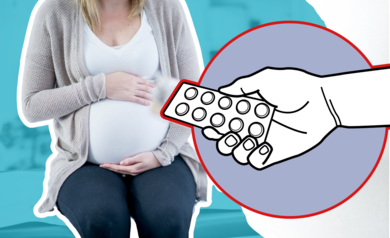- Health Conditions A-Z
- Health & Wellness
- Nutrition
- Fitness
- Health News
- Ayurveda
- Videos
- Medicine A-Z
- Parenting
- Web Stories
Why Everyone Is Suddenly Talking About Ivermectin As A Cancer Breakthrough?

A PubMed search for “ivermectin” and “cancer” yields hundreds of preclinical studies, many conducted on cell cultures or mice. In the sector of alternative cancer treatments, few drugs have generated as much buzz—and controversy—as ivermectin. Once lauded for its ability to treat parasitic infections and awarded a Nobel Prize for its contribution to global health, ivermectin has more recently been at the center of misleading narratives, first as an alleged cure for COVID-19 and now as a so-called “cancer breakthrough.”
Social media, podcasts, and even some patient communities are abuzz with stories of miraculous recoveries and scientific “breakthroughs.” But what’s driving this surge of interest, and does the science live up to the hype?
For decades, ivermectin was best known as a safe and effective treatment for parasitic diseases like river blindness and scabies. Its impact was so significant that it earned its discoverers the Nobel Prize in 2015. But after being widely discredited as a COVID-19 treatment, ivermectin found new life in online cancer forums and alternative health circles, where it’s now promoted as a cheap, accessible alternative to mainstream cancer therapies.
The renewed interest in ivermectin as a potential cancer therapy has largely been driven by non-scientific sources. On platforms like X (formerly Twitter), Substack, and YouTube, influential figures promote ivermectin as a natural, low-cost cure "suppressed by big pharma."
One viral moment came during a widely viewed episode of The Joe Rogan Experience, in which actor Mel Gibson recounted how three friends with stage IV cancer reportedly became cancer-free after taking ivermectin and fenbendazole. That snippet, viewed by nearly 20 million people, has fueled speculation—despite the anecdotal nature of the claims.
Further fanning the flames, public figures like Robert F. Kennedy Jr. have accused health authorities of deliberately suppressing ivermectin to favor profit-driven cancer treatments—a claim lacking credible evidence but resonating with those distrustful of traditional medicine.
What Is Ivermectin Approved For?
Ivermectin is a U.S. FDA-approved antiparasitic drug, used for treating river blindness (onchocerciasis), strongyloidiasis, lice, and scabies in humans. It’s also commonly used in veterinary medicine to treat parasitic infections in animals.
Its development and application in tropical medicine were so impactful that the researchers behind ivermectin received the Nobel Prize in 2015. However, its uses have always remained confined to parasitic infections—not viral illnesses like COVID-19, and certainly not cancer.
How Ivermectin Might Work Against Cancer?
Ivermectin’s anticancer effects appear to be unrelated to its anti-parasitic action. Instead, the drug disrupts cancer cell signaling, impairs mitochondrial function, induces autophagy (a process that can kill cancer cells), and inhibits cancer stem cells. It also weakens the mechanisms that allow tumors to resist chemotherapy and evade the immune system.
In the Brazilian rat study, nano-encapsulated ivermectin not only shrank tumors but also improved the health of surrounding brain tissue and reduced abnormal blood vessel growth—suggesting multiple avenues of attack against cancer.
What the Science Says About Ivermectin and Cancer?
A search of scientific literature reveals hundreds of studies linking ivermectin to cancer research. Some of these suggest that ivermectin may interfere with cancer cell metabolism, inhibit tumor growth, or boost immune response in lab-controlled environments. But—and this is critical—lab results do not equal human results.
Dr. Peter P. Lee, chair of the Department of Immuno-Oncology at the Beckman Research Institute of City of Hope, has studied ivermectin's immune-stimulating effects in mice. While findings hinted at some tumor-modulating potential, they fell far short of demonstrating therapeutic value in humans.
At the 2025 American Society of Clinical Oncology (ASCO) Annual Meeting, early results from a phase 1/2 trial combining ivermectin with immunotherapy in metastatic triple-negative breast cancer patients showed no significant benefit. Of the eight patients evaluated, six experienced disease progression, one had a partial response, and one achieved stable disease.
Risks of Using Ivermectin as a Cancer Therapy
Promoting ivermectin for cancer without evidence carries several dangers:
Neurological toxicity: High doses can lead to seizures, confusion, blurred vision, or even coma.
Drug interactions: Ivermectin can interfere with common cancer medications, such as blood thinners or immunotherapy agents.
Treatment delays: Perhaps most concerning is the risk that patients may delay or forgo evidence-based cancer treatments in favor of unproven, alternative drugs. Such delays can allow the cancer to progress unchecked.
False hope and financial exploitation: Some patients may spend time, money, and emotional energy pursuing unproven remedies, only to face worsening outcomes.
Why the Sudden Surge in Popularity?
Several factors have converged to make ivermectin a hot topic in cancer circles. Social media amplification has played a major role, with influencers and alternative health advocates promoting ivermectin as a cheap, “natural” alternative to mainstream cancer treatments. These promotions often rely on cherry-picked studies or anecdotal stories of success, rather than clinical evidence. Distrust in conventional oncology also fuels interest—many patients, disillusioned by the side effects, financial burden, or perceived limitations of standard therapies, are increasingly drawn to off-label or experimental alternatives like ivermectin.
Preclinical breakthroughs, such as the much-publicized Brazilian nano-ivermectin study in animals, add to the intrigue by generating hopeful headlines, despite lacking human trial data. Finally, political and cultural overtones stemming from ivermectin’s controversial use during the COVID-19 pandemic have transformed the drug into a rallying point for individuals skeptical of established medical authorities, further complicating the public narrative around its potential role in cancer treatment.
Where Does This Leave Patients and Doctors?
While the science around ivermectin and cancer is evolving, the consensus among oncologists and researchers is clear: There is no solid evidence that ivermectin can cure or significantly treat cancer in humans. The most promising findings are still limited to laboratory and animal studies, and ongoing clinical trials have yet to show meaningful benefit in people.
That said, the safety profile in small studies is reassuring, and the innovative use of nanotechnology to deliver ivermectin to brain tumors is a genuine scientific advance—one that warrants further research but not premature celebration.
Curiosity Is Good—But Let's Stick to the Science
The buzz around ivermectin as a cancer cure is based more on anecdotes and viral claims than on real science. While early lab data may inspire future studies, there is currently no evidence that ivermectin can treat or cure cancer in humans. Ivermectin’s journey from Nobel-winning anti-parasitic to cancer “miracle drug” is a testament to both the power of scientific curiosity and the dangers of viral misinformation.
Patients facing cancer deserve hope—but not false hope. Turning away from proven therapies in favor of unproven ones could have devastating consequences.
Is Tylenol Safe During Pregnancy? Scientists Question Autism & ADHD Risk

Credits: Health and me
Paracetamol or Tylenol is a popular pain and fever medication for decades for all and especially for pregnant women. Its safety record has for many years stood above the rest of the over-the-counter medications and is therefore used as the first-line medication for headache, fever, and mild pain in pregnancy. But new studies at Mount Sinai and Harvard T.H. Chan School of Public Health have opened the door to an important discussion: is prenatal exposure to acetaminophen associated with neurodevelopmental disorders including autism spectrum disorder (ASD) and attention-deficit/hyperactivity disorder (ADHD) in children?
A study led by Andrea Baccarelli, dean of Harvard T.H. Chan School of Public Health’s faculty of environmental health, published on August 14 in BMC Environmental Health, systematically reviewed 46 previous studies encompassing data from more than 100,000 participants. The aim was to investigate whether acetaminophen use during pregnancy correlates with neurodevelopmental disorders in children.
Applying the Navigation Guide Systematic Review method—a strict, gold-standard approach to assessing environmental health evidence—the study team evaluated the quality, risk of bias, and strength of evidence of all included research. By doing so, it was possible to conduct a solid synthesis of available scientific literature, and what emerged was a pattern: better-quality studies more often showed an association between prenatal acetaminophen exposure and offspring increased risk of ADHD and autism.
Researchers at the Icahn School of Medicine at Mount Sinai reiterated these alarms. The research highlighted that acetaminophen is not without risk, particularly considering its heavy use—more than half of pregnant women worldwide reportedly use it. Although the research does not establish causation, biological pathways may provide some insight. Acetaminophen passes through the placental membrane, which may initiate oxidative stress, hormonal disruption, and epigenetic changes that can disrupt fetal brain development.
Dr. Diddier Prada, a population health science and policy and environmental medicine assistant professor at Mount Sinai, pointed to the larger picture: "With so many people taking this drug, even a modest increase in risk could have huge public health implications."
How To Balance Risks and Usage?
What this actually indicates is not that pregnant women should never take acetaminophen—not at all. Fever and unrelieved pain during pregnancy are actually risks to the fetus as well, risks of miscarriage, preterm labor, and developmental problems. Rather, researchers at both Harvard and Mount Sinai simply suggest the use of acetaminophen with restraint: the minimum dose that will be effective, for as short a period as possible, always under a physician's care.
Clinical practice guidelines in the U.S., such as those of the American College of Obstetricians and Gynecologists, still favor acetaminophen over nonsteroidal anti-inflammatory agents such as ibuprofen, which are usually avoided in the second and third trimesters. The focus is on personalized risk-benefit evaluation, not blanket bans.
Although the new evidence raised some eyebrows, not all research supports an association. For example, in 2024, the Swedish cohort of about 2 million children, of which more than 180,000 were exposed to acetaminophen during pregnancy, identified no evidence of association with autism, ADHD, or intellectual disability. Likewise, previously, the FDA and the Society for Maternal-Fetal Medicine suggested that current studies are inconclusive or too small in number to change recommendations.
These contradictory findings demonstrate the nuance of research on prenatal effects of medication. Neurodevelopmental conditions such as autism and ADHD are affected by a wide range of genetic, environmental, and lifestyle variables. Separating the effect of acetaminophen from these elements is difficult, and large-scale, high-quality longitudinal studies are needed.
Why Is Tylenol A Concern For Pregnant Women?
Scientists investigating biological mechanisms have observed that acetaminophen has the potential to affect fetal brain growth through several mechanisms:
Oxidative Stress: Metabolism of acetaminophen can produce reactive oxygen species that could interfere with usual neural development.
Hormonal Disruption: Changes in maternal hormone levels may indirectly influence fetal neurodevelopment.
Epigenetic Changes: Exposure can induce changes in gene expression without changing DNA sequences, which can impact cognitive and behavioral outcomes.
Though these mechanisms are still being studied, they are a reasonable hypothesis for why some have seen associations with ADHD and autism.
How Does It Affect Future Prenatal Care?
The results have important public health consequences. Acetaminophen is the most widely used over-the-counter medication among pregnant women, so even a modest increase in risk of neurodevelopment would impact huge populations worldwide. The study highlights the necessity of new clinical guidelines, improved patient education, and investment in safer alternatives for pain and fever management for pregnant women.
Researchers emphasize that pregnant women should not stop taking acetaminophen on their own. Rather, open communication between healthcare providers and pregnant women is essential, comparing untreated pain and fever risk against possible neurodevelopmental issues. Non-pharmacologic pain relief, rest, and hydration can be considered when appropriate.
As ADHD and autism diagnoses surge globally, knowing the environmental and drug causes of neurodevelopment becomes ever more pressing. This research contributes to mounting evidence calling for caution in prenatal use of acetaminophen, while continuing to support further study to establish causation, dose-response, and alternative safer medicines.
Tylenol is still widely used as a suggested painkiller and fever reducer during pregnancy. However, recent research has shown possible associations with ADHD and autism in kids, which has led scientists to recommend careful, short-term use under medical guidance. Women in pregnancy should consult their doctor concerning any pain relief plan, weighing current needs against possible long-term impacts on child development.
Rebuilding Intimacy After Miscarriage Could Be Tough: Experts Weigh In On The Psychological And Physical Aspects

Credits: Canva
A miscarriage isn’t just about physical loss. It often brings a mix of emotions like grief, guilt, anxiety, and confusion that can seep into every corner of a relationship. Couples who once shared dreams of parenthood might suddenly find themselves navigating silence, distance, or mismatched timelines of healing. And when it comes to intimacy, things can get especially tricky.
Here is how to rebuild closeness — both emotional and physical — after such a painful experience, according to the experts.
Your Body and Heart Need Different Timelines
According to Dr Astha Dayal, Director of Obstetrics and Gynaecology at CK Birla Hospital, the body usually needs 2–3 weeks to recover after a miscarriage, though this varies depending on how far along the pregnancy was. But emotional healing? That’s a whole different ballgame.
“There is no fixed timeline for the heart,” she says. “One partner may feel ready to reconnect sooner, while the other needs more time. This is normal and should be respected.”
Instead of pressuring yourself to “move on”, Dr Dayal suggests giving yourself permission to simply be — whether that means sitting with sadness, embracing small joys, or telling your partner that intimacy feels overwhelming right now.
Why Miscarriage Happens
One of the hardest parts of miscarriage is the guilt that many women (and their partners) carry. But Dr Yashica Gudesar, Director and Unit Head, Obstetrics and Gynaecology, Max Super Speciality Hospital, wants couples to remember this: in almost 95% of cases, miscarriages happen for reasons beyond your control.
“Sometimes the mother’s health isn’t ideal, or the foetus develops with genetic flaws,” she explains. “The body ends the pregnancy because nature itself won’t allow a genetically abnormal foetus to develop.”
That means it’s not your fault. It’s not punishment. It’s not a failure. Understanding this can lift some of the emotional burden, making it easier to focus on healing together.
Redefining Intimacy
Sex isn’t the only way to feel close. In fact, after miscarriage, starting small is the healthiest approach.
“Intimacy doesn’t have to mean intercourse,” says Dr Dayal. “Physical touch, cuddling, or even just walking together can help rebuild closeness.”
Dr Gudesar echoes this, emphasising the power of “little gestures”, like holding hands, hugging, or sitting together in silence. These micro-moments can carry more weight than you think, offering comfort without pressure.
Reconnecting With Your Body
For many women, miscarriage brings a sense of betrayal by their own body. The very vessel meant to nurture life has instead let them down or at least, that’s how it can feel.
Dr Dayal encourages women to slowly rebuild trust with their bodies through gentle self-care. “Yoga, breathing exercises, or mindful walks can help you feel grounded again,” she says. This reconnection can lay the foundation for physical intimacy later.
When You’re Ready and When You’re Not
Physically, most doctors advise waiting 2–4 weeks before resuming sexual activity. Even then, discomfort, vaginal dryness, or emotional blockages can get in the way. Lubricants can help, but if pain persists, it’s important to see a gynaecologist to rule out infection or complications.
And if the thought of another pregnancy feels too soon, don’t hesitate to discuss contraception with your doctor. The point is to move forward at your pace, not society’s checklist.
Talking It Out
Miscarriage affects partners differently. One may crave intimacy for comfort, while the other pulls away. Left unspoken, this mismatch can create cracks in the relationship.
“Even ten minutes of open and honest conversation can prevent resentment,” says Dr Dayal. Whether it’s admitting you’re not ready, sharing fears, or simply saying you miss each other, these small exchanges go a long way.
Calling in Reinforcements
Sometimes, love alone isn’t enough to mend the emotional chasm left by miscarriage. That’s where counselling or therapy can make a difference.
Dr Gudesar recommends professional or peer support: “Talking to a therapist or joining a support group can help normalise the complex emotions couples face after miscarriage.” It also offers tools to navigate the grieving process without losing the bond between partners.
Patience, Grace, and Second Chances
Both experts agree on one thing: there is no single “right” way to heal. What matters most is patience — with yourself, your partner, and your body.
“Most women eventually go on to have healthy pregnancies,” Dr Dayal reminds us. “But emotional and physical healing doesn’t always happen at the same time. Give yourself grace to rediscover intimacy at your own pace.”
What Really Happens in Hernia Surgery? A Clear, Patient-Friendly Guide to All the Types Explained

Credits: Canva
You bend to lift a bag, sneeze a little too hard, or notice a strange bulge that was not there before. That small lump in your abdomen could be a hernia. While the word itself can sound alarming, hernia surgery today is routine and safe and comes in different types depending on your condition.
What’s a hernia?
A hernia is when an organ, often the gut or fatty tissue, pokes through a weak spot in your abdominal wall. Dr Pushkar Anand Singh, Senior Consultant – General and Laparoscopic Surgeon at Shri Ram Singh Hospital, explains it like this: “Think of it like a bulge in a worn-out tyre. The wall is supposed to hold everything in, but a weak spot lets the insides push out.”
This weak spot may form due to overexertion, like unsupervised weightlifting, constipation, or chronic cough, or it could be congenital (you were born with it). Sometimes it even develops at the site of an old surgery.
Who actually needs surgery?
Not everyone who discovers a hernia needs to be wheeled into an operating theatre right away. According to Dr Shrey Srivastava, Senior Consultant in Internal Medicine at Sharda Hospital, Greater Noida, surgery is usually advised when the hernia becomes painful, interferes with daily activities, or risks dangerous complications.
“Hernias that cannot be pushed back in, those that cause increasing pain, or worse, strangulated hernias where blood supply is cut off, need urgent surgery,” he says. Without timely intervention, this can lead to tissue death and potentially life-threatening infection.
On the flip side, if a hernia is tiny, painless, and not causing trouble, your doctor may simply keep an eye on it. But the general rule is that a hernia will not magically disappear on its own; sooner or later, surgery might be on the cards.
Open Hernia Repair
This is the old-school, tried-and-tested method. Surgeons make an incision right over the hernia, carefully push the bulging tissue back into place, repair the defect, and then reinforce the area with a mesh (like patching up that worn-out tyre).
“Open repair is highly cost-effective, and the outcomes are comparable with newer techniques,” says Dr Singh. For many patients, it remains the go-to option, especially when budget is a concern.
Laparoscopic Hernia Repair
Here, instead of one big cut, surgeons make three or four tiny incisions to slip in a camera and surgical instruments. The mesh is placed from the inside, which means no obvious scar at the hernia site.
The perks are smaller cuts, quicker healing, and less pain afterwards. However, it costs more, and as Dr Singh points out, “It is not recommended for patients with significant heart or lung issues, as the procedure puts more strain on the body.”
Robotic-Assisted Hernia Repair
Robots in surgery may sound like something out of a sci-fi movie, but they are here. Robotic-assisted hernia repair builds on the laparoscopic method, except the tools are controlled through a robotic console.
“The technology allows greater precision and 3D visualisation for the surgeon,” explains Dr Singh. It is slick and advanced, but it also comes with a hefty price tag. Since the outcomes are not dramatically better than laparoscopic surgery, most hospitals do not see it as a routine option.
How do doctors decide which is right?
With three different techniques on the table, how do surgeons pick? Dr Singh says the choice depends on several factors like patient health, cost considerations, size of the hernia, and the urgency of the situation.
Open surgery might suit a patient looking for a straightforward, affordable solution. Laparoscopic repair works well for those who want a quicker recovery and can afford the added cost. Robotic surgery, while cool, is usually reserved for centres with access to the technology and patients willing to pay extra for the latest option.
Do not fear the word “surgery”
While the thought of going under the knife can be nerve-wracking, hernia surgeries today are routine, safe, and highly successful. Most patients return to normal activities within weeks, and the mesh reinforcement greatly reduces the risk of recurrence.
“Hernias are common, but complications can be dangerous,” Dr Srivastava reminds. “If you are experiencing persistent pain, visible bulges, or swelling that would not go back inside, do not delay consulting a doctor.”
© 2024 Bennett, Coleman & Company Limited

